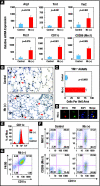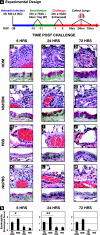Hookworm-induced persistent changes to the immunological environment of the lung
- PMID: 18505812
- PMCID: PMC2493237
- DOI: 10.1128/IAI.00192-08
Hookworm-induced persistent changes to the immunological environment of the lung
Abstract
A number of important helminth parasites of humans have incorporated short-term residence in the lungs as an obligate phase of their life cycles. The significance of this transient pulmonary exposure to the infection and immunity is not clear. Employing a rodent model of infection with hookworm (Nippostrongylus brasiliensis), we characterized the long-term changes in the immunological status of the lungs induced by parasite infection. At 36 days after infection, alterations included a sustained increase in the transcription of both Th2 and Th1 cytokines as well as a significant increase in the number and frequency of alveolar macrophages displaying an alternatively activated phenotype. While N. brasiliensis did not induce alternate activation of lung macrophages in STAT6(-/-) animals, the parasite did induce a robust Th17 response in the pulmonary environment, suggesting that STAT6 signaling plays a role in modulating Th17 immunity and pathology in the lungs. In the context of the cellular and molecular changes induced by N. brasiliensis infection, there was a significant reduction in overall airway responsiveness and lung inflammation in response to allergen. In addition, the N. brasiliensis-altered pulmonary environment showed dramatic alterations in the nature and number of genes that were up- and downregulated in the lung in response to allergen challenge. The results demonstrate that even a transient exposure to a helminth parasite can effect significant and protracted changes in the immunological environment of the lung and that these complex molecular and cellular changes are likely to play a role in modulating a subsequent allergen-induced inflammatory response.
Figures








Similar articles
-
Innate immune responses to lung-stage helminth infection induce alternatively activated alveolar macrophages.Infect Immun. 2006 Sep;74(9):4970-81. doi: 10.1128/IAI.00687-06. Infect Immun. 2006. PMID: 16926388 Free PMC article.
-
Antecedent Nippostrongylus infection alters the lung immune response to Plasmodium berghei.Parasite Immunol. 2017 Aug;39(8):10.1111/pim.12441. doi: 10.1111/pim.12441. Epub 2017 Jun 1. Parasite Immunol. 2017. PMID: 28475238 Free PMC article.
-
Alternatively activated macrophages inhibit T-cell proliferation by Stat6-dependent expression of PD-L2.Blood. 2010 Oct 28;116(17):3311-20. doi: 10.1182/blood-2010-02-271981. Epub 2010 Jul 12. Blood. 2010. PMID: 20625006
-
Nippostrongylus brasiliensis infection leads to the development of emphysema associated with the induction of alternatively activated macrophages.Eur J Immunol. 2008 Feb;38(2):479-88. doi: 10.1002/eji.200737827. Eur J Immunol. 2008. PMID: 18203142
-
The role of ILC2 in hookworm infection.Parasite Immunol. 2018 Feb;40(2). doi: 10.1111/pim.12429. Epub 2017 May 22. Parasite Immunol. 2018. PMID: 28369954 Review.
Cited by
-
Parasites and asthma.Parasitol Res. 2017 Sep;116(9):2373-2383. doi: 10.1007/s00436-017-5548-1. Epub 2017 Jul 8. Parasitol Res. 2017. PMID: 28689246 Review.
-
First Responders: Innate Immunity to Helminths.Trends Parasitol. 2018 Oct;34(10):861-880. doi: 10.1016/j.pt.2018.08.007. Epub 2018 Aug 31. Trends Parasitol. 2018. PMID: 30177466 Free PMC article. Review.
-
Development of CD4 T Cell Dependent Immunity Against N. brasiliensis Infection.Front Immunol. 2013 Mar 20;4:74. doi: 10.3389/fimmu.2013.00074. eCollection 2013. Front Immunol. 2013. PMID: 23518620 Free PMC article.
-
Concomitant influence of helminth infection and landscape on the distribution of Puumala hantavirus in its reservoir, Myodes glareolus.BMC Microbiol. 2011 Feb 8;11(1):30. doi: 10.1186/1471-2180-11-30. BMC Microbiol. 2011. PMID: 21303497 Free PMC article.
-
Comprehensive Transcriptome Meta-analysis to Characterize Host Immune Responses in Helminth Infections.PLoS Negl Trop Dis. 2016 Apr 8;10(4):e0004624. doi: 10.1371/journal.pntd.0004624. eCollection 2016 Apr. PLoS Negl Trop Dis. 2016. PMID: 27058578 Free PMC article.
References
-
- Allen, J. E., and R. M. Maizels. 1996. Immunology of human helminth infection. Int. Arch. Allergy Immunol. 1093-10. - PubMed
-
- Araujo, M. I., A. A. Lopes, M. Medeiros, A. A. Cruz, L. Sousa-Atta, D. Sole, and E. M. Carvalho. 2000. Inverse association between skin response to aeroallergens and Schistosoma mansoni infection. Int. Arch. Allergy Immunol. 123145-148. - PubMed
-
- Arora, S., Y. Hernandez, J. R. Erb-Downward, R. A. McDonald, G. B. Toews, and G. B. Huffnagle. 2005. Role of IFN-gamma in regulating T2 immunity and the development of alternatively activated macrophages during allergic bronchopulmonary mycosis. J. Immunol. 1746346-6356. - PubMed
-
- Bashir, M. E., P. Andersen, I. J. Fuss, H. N. Shi, and C. Nagler-Anderson. 2002. An enteric helminth infection protects against an allergic response to dietary antigen. J. Immunol. 1693284-3292. - PubMed
Publication types
MeSH terms
Substances
Associated data
- Actions
Grants and funding
LinkOut - more resources
Full Text Sources
Molecular Biology Databases
Research Materials
Miscellaneous

